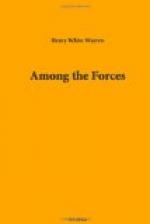No. 3 of the illustrations here given represents such a great excavation one hundred feet back from the shore. It is one hundred and fifty feet long by ninety wide and over fifty feet deep. All the material had been carried out to sea by the refluent wave. On the natural bridge seen in front the great crowd in Broadway, New York, might pass or a troop of cavalry could be maneuvered. Through the arch a ship with masts thirty feet high might enter at high tide. Through the abutment of the arch where the afternoon sun pours its brightness the waves have cut other arches not visible in the picture. When the arches become too many or too wide the natural bridge will fall and be carried out to sea like many another.
[Illustration: A Natural Bridge, Santa Cruz, Cal.]
But what does the sea do with the harder parts of the cliff? Its waves wear away the rock on each side and leave one or more long fingers reaching out into the sea. The wear and tear on such a projection is immense. A strong swimmer may play with the breakers away from the cliff. At exactly the right moment he may dive headlong through the pearly green Niagara that has not yet fallen quite to his head and may sport in the comparatively quiet water beyond, while the wild ruin falls with a sound of thunder on the beach. But let him once be caught and dashed against the rocks and there is no more life or wholeness of bones within him.
In the swirl of converging currents between two rocky projections, as the coarse sand and gravel is surged around a few hundred thousand times, there is a great tendency to wear through the wall of the projecting finger. It is often done. Illustration No. 4 shows at low tide such a projection cut through. Since the picture was taken the bridge has fallen, the detritus been carted away by the waves, and the pier stands lonely in the sea.
[Illustration: An Excavated Arch, Santa Cruz, Cal.]
No. 5 shows one bridge exceedingly frail and another more substantial nearer the famous Cliff Drive. I go to the frail one every year with anxiety lest I shall find it has been carried away. How I wish I could show my readers the delicate sculpture and carving further back, nearer yet to the drive. But note the various strata, the rocks worn to a point as even the milder waves run over them; note the cracks that tell of the awful push and stress of the titanic struggle.
[Illustration: A Double Natural Arch, Santa Cruz, Cal.]
Illustration No. 6 shows three such under-hewn arches. The long projection of rock is so curved as to prevent the arches being fully seen in any one view. I have waded and swam through these rocky vistas, and there, where any more than moderate waves would have mangled me against the tusks of the cruel rocks, I have found little specimens of aquatic life by the millions, clinging fast to the rocks that were home to them and protecting themselves by taking lime out of the water and building such a solid wall of shell that no fierceness of the wildest storm could work them harm. All these seek their food from Him who feeds all life, and he heaves the ocean up to their mouths that they may drink.




